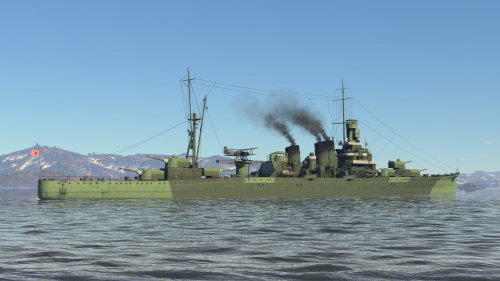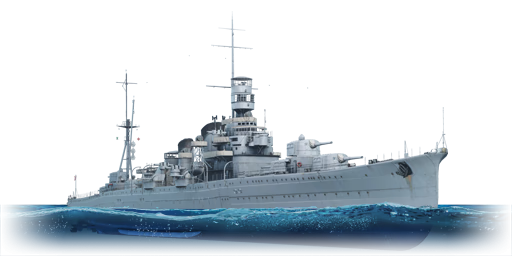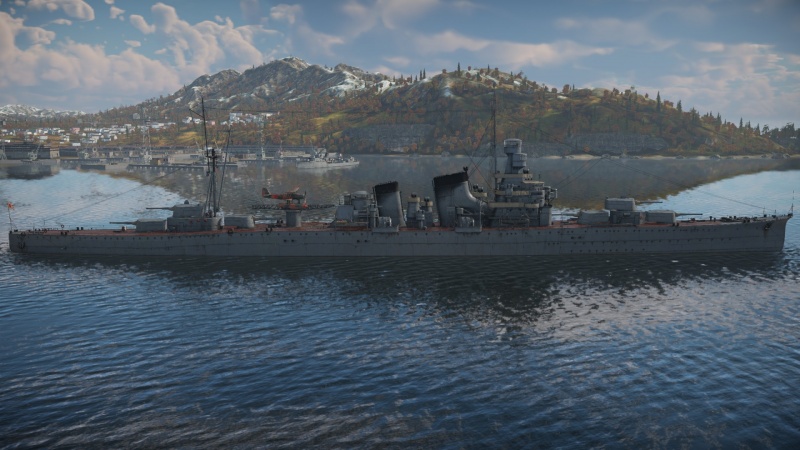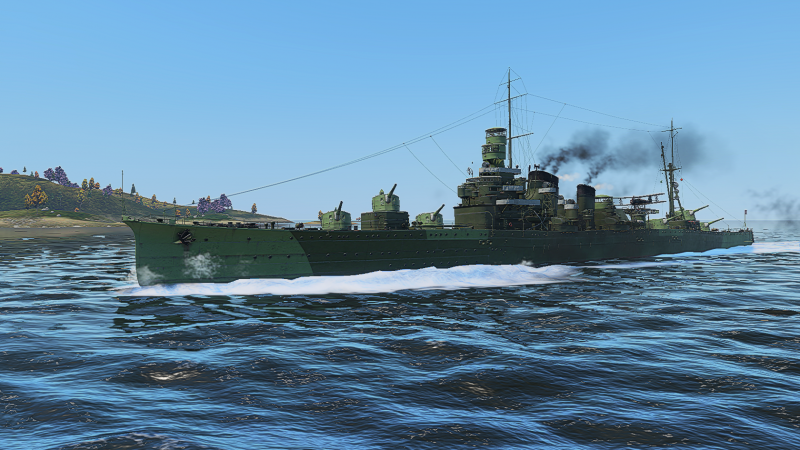Difference between revisions of "IJN Kako"
m |
Colok76286 (talk | contribs) (Edits) |
||
| Line 1: | Line 1: | ||
{{About | {{About | ||
| about = Japanese heavy cruiser '''{{PAGENAME}}''' | | about = Japanese heavy cruiser '''{{PAGENAME}}''' | ||
| − | | usage = other | + | | usage = other Furutaka-class cruisers |
| link = Furutaka (Family) | | link = Furutaka (Family) | ||
}} | }} | ||
| Line 13: | Line 13: | ||
The '''{{Specs|name}}''' is a rank {{Specs|rank}} Japanese heavy cruiser {{Battle-rating}}. It was introduced in [[Update 1.89 "Imperial Navy"]]. | The '''{{Specs|name}}''' is a rank {{Specs|rank}} Japanese heavy cruiser {{Battle-rating}}. It was introduced in [[Update 1.89 "Imperial Navy"]]. | ||
| − | Designed to meet the 7,500- | + | Designed to meet the 7,500-ton displacement restrictions of the Washington naval treaty, the early refit Kako features several unique quirks for a heavy cruiser. To reduce the weight of the ship, the Kako features only few secondary and AA mounts. While this made her particularly vulnerable against aerial threats, the result is that the Kako has only 8,640 tons of displacement - comparable to most of the post-treaty light cruisers - while having greater protection compared to ships of a similar or higher displacement, as well as similar good mobility. |
| + | |||
== General info == | == General info == | ||
=== Survivability and armour === | === Survivability and armour === | ||
{{Specs-Fleet-Armour}} | {{Specs-Fleet-Armour}} | ||
| − | For a heavy cruiser, the Kako's protection is average. The main citadel is covered with 76.2 mm of RHA and citadel deck armour varies between 31.75 to 34. | + | <!-- ''Talk about the vehicle's armour. Note the most well-defended and most vulnerable zones, e.g. the ammo magazine. Evaluate the composition of components and assemblies responsible for movement and manoeuvrability. Evaluate the survivability of the primary and secondary armaments separately. Don't forget to mention the size of the crew, which plays an important role in fleet mechanics. Save tips on preserving survivability for the "Usage in battles" section. If necessary, use a graphical template to show the most well-protected or most vulnerable points in the armour.'' --> |
| + | For a heavy cruiser, the Kako's protection is average. The main citadel is covered with 76.2 mm of RHA and citadel deck armour varies between 31.75 to 34.9 mm. The armour can withstand a fair amount of beatings from mid-to-long ranges (6 km or more), thought became much more vulnerable when not angled. | ||
| + | |||
| + | While the Kako features a low crew count of 616 men, she is able to maintain most of her crew due to the lack of secondary and AA mounts, which means she will only lose sailors when the crew compartment is damaged. | ||
| − | + | Along with her sister ship [[IJN Furutaka|Furutaka]], the Kako has the unique perk of being able to withstand fire damage with little to no crew loss due to her crew compartments is located further away from the deck and are spaced from each other. This ability makes the Kako much more bearable for new captains who don't have FPE, and allows experienced captains to focus on repairing the more serious damage on the ship. | |
| − | |||
=== Mobility === | === Mobility === | ||
{{Specs-Fleet-Mobility}} | {{Specs-Fleet-Mobility}} | ||
| + | <!-- 'Write about the ship's mobility. Evaluate its power and manoeuvrability, rudder rerouting speed, stopping speed at full tilt, with its maximum forward and reverse speed.'' --> | ||
Due to her low displacement, the Kako features good mobility that is comparable to a light cruisers. She can accelerate and decelerate faster compared to other heavy cruisers and turns quite well when upgraded. | Due to her low displacement, the Kako features good mobility that is comparable to a light cruisers. She can accelerate and decelerate faster compared to other heavy cruisers and turns quite well when upgraded. | ||
| Line 70: | Line 74: | ||
* Good top speed and agility | * Good top speed and agility | ||
* Good survivability | * Good survivability | ||
| − | ** Very durable against | + | ** Very durable against destroyers |
** Can bounce several shots when angled properly | ** Can bounce several shots when angled properly | ||
** Resilient against fire damage | ** Resilient against fire damage | ||
| − | * Carries large amount of torpedoes | + | * Carries large amount of torpedoes |
'''Cons:''' | '''Cons:''' | ||
| Line 96: | Line 100: | ||
;Skins | ;Skins | ||
| − | + | * [https://live.warthunder.com/feed/camouflages/?vehicle=jp_cruiser_kako Skins and camouflages for the {{PAGENAME}} from live.warthunder.com.] | |
| − | * [https://live.warthunder.com/feed/camouflages/? | + | {{Skin-gallery |market|ugcitem_1000467|Kako Merchant Fleet camouflage.png|Camo "Merchant Fleet camouflage"}} |
| − | |||
| − | {{Skin-gallery | ||
| − | |||
| − | }} | ||
== See also == | == See also == | ||
''Links to articles on the War Thunder Wiki that you think will be useful for the reader, for example:'' | ''Links to articles on the War Thunder Wiki that you think will be useful for the reader, for example:'' | ||
| − | |||
* ''reference to the series of the ship;'' | * ''reference to the series of the ship;'' | ||
* ''links to approximate analogues of other nations and research trees.'' | * ''links to approximate analogues of other nations and research trees.'' | ||
| Line 111: | Line 110: | ||
== External links == | == External links == | ||
''Paste links to sources and external resources, such as:'' | ''Paste links to sources and external resources, such as:'' | ||
| − | |||
* ''topic on the official game forum;'' | * ''topic on the official game forum;'' | ||
| − | |||
* ''other literature.'' | * ''other literature.'' | ||
{{Japan heavy cruisers}} | {{Japan heavy cruisers}} | ||
Revision as of 12:29, 12 October 2021
| This page is about the Japanese heavy cruiser IJN Kako. For other Furutaka-class cruisers, see Furutaka (Family). |
Contents
Description
The Furutaka-class, IJN Kako, (1935) is a rank III Japanese heavy cruiser with a battle rating of 4.7 (AB/RB/SB). It was introduced in Update 1.89 "Imperial Navy".
Designed to meet the 7,500-ton displacement restrictions of the Washington naval treaty, the early refit Kako features several unique quirks for a heavy cruiser. To reduce the weight of the ship, the Kako features only few secondary and AA mounts. While this made her particularly vulnerable against aerial threats, the result is that the Kako has only 8,640 tons of displacement - comparable to most of the post-treaty light cruisers - while having greater protection compared to ships of a similar or higher displacement, as well as similar good mobility.
General info
Survivability and armour
For a heavy cruiser, the Kako's protection is average. The main citadel is covered with 76.2 mm of RHA and citadel deck armour varies between 31.75 to 34.9 mm. The armour can withstand a fair amount of beatings from mid-to-long ranges (6 km or more), thought became much more vulnerable when not angled.
While the Kako features a low crew count of 616 men, she is able to maintain most of her crew due to the lack of secondary and AA mounts, which means she will only lose sailors when the crew compartment is damaged.
Along with her sister ship Furutaka, the Kako has the unique perk of being able to withstand fire damage with little to no crew loss due to her crew compartments is located further away from the deck and are spaced from each other. This ability makes the Kako much more bearable for new captains who don't have FPE, and allows experienced captains to focus on repairing the more serious damage on the ship.
Mobility
Due to her low displacement, the Kako features good mobility that is comparable to a light cruisers. She can accelerate and decelerate faster compared to other heavy cruisers and turns quite well when upgraded.
| Mobility Characteristics | |||
|---|---|---|---|
| Game Mode | Upgrade Status | Maximum Speed (km/h) | |
| Forward | Reverse | ||
| AB | |||
| Upgraded | 76 | 21 | |
| RB/SB | |||
| Upgraded | 65 | 18 | |
Modifications and economy
Armament
Primary armament
Provide information about the characteristics of the primary armament. Evaluate their efficacy in battle based on their reload speed, ballistics and the capacity of their shells. Add a link to the main article about the weapon: {{main|Weapon name (calibre)}}. Broadly describe the ammunition available for the primary armament, and provide recommendations on how to use it and which ammunition to choose.
Secondary armament
Some ships are fitted with weapons of various calibres. Secondary armaments are defined as weapons chosen with the control Select secondary weapon. Evaluate the secondary armaments and give advice on how to use them. Describe the ammunition available for the secondary armament. Provide recommendations on how to use them and which ammunition to choose. Remember that any anti-air armament, even heavy calibre weapons, belong in the next section. If there is no secondary armament, remove this section.
Anti-aircraft armament
An important part of the ship's armament responsible for air defence. Anti-aircraft armament is defined by the weapon chosen with the control Select anti-aircraft weapons. Talk about the ship's anti-air cannons and machine guns, the number of guns and their positions, their effective range, and about their overall effectiveness – including against surface targets. If there are no anti-aircraft armaments, remove this section.
Additional armament
Describe the available additional armaments of the ship: depth charges, mines, torpedoes. Talk about their positions, available ammunition and launch features such as dead zones of torpedoes. If there is no additional armament, remove this section.
Usage in battles
Describe the technique of using this ship, the characteristics of her use in a team and tips on strategy. Abstain from writing an entire guide – don't try to provide a single point of view, but give the reader food for thought. Talk about the most dangerous opponents for this vehicle and provide recommendations on fighting them. If necessary, note the specifics of playing with this vehicle in various modes (AB, RB, SB).
Pros and cons
Pros:
- Great main armament
- 6 powerful 200 mm (7.9 inch) cannons
- Guns have separate turrets which allows to keep more firepower active as a turret gets taken out
- Able to do full boardsides from very steep angles
- Good top speed and agility
- Good survivability
- Very durable against destroyers
- Can bounce several shots when angled properly
- Resilient against fire damage
- Carries large amount of torpedoes
Cons:
- Torpedo launchers are fixed, unable to be traversed without moving the hull
- 7.9 inch guns are very inaccurate especially compared to her sistership (IJN Furutaka) with the newer, larger guns.
- Early war Japanese fit
- Weak anti-air capability
- Slow turret traverse
- Large target and usually priority targeted over other vessels
History
Created as a counter to the American Omaha and British Hawkins class cruisers, the Furutaka class was designed to act as a scouting cruiser capable of protecting the main fleet from enemy scouts. While the ship was designed before the Washington Naval Treaty, she still fell within the displacement and calibre limits with 7,500 tons of displacement and the main armament of six 7.9 in/20 cm cannons mounted in single turrets; she also had a torpedo armament of 12 x 21-inch torpedo tubes mounted in the hull. These armaments would change as both Furutaka and Kako were modernized shortly after being completed, with their single mounted guns being replaced with three twin turrets and two quad-torpedo launchers being added near the aft.
During the first months of the Pacific War against the United States, Kako was assigned to Sentai 6 and tasked in covering the invasions of several islands including Guam, Wake, and New Guinea. Sentai 6 was then assigned to Operation MO, the invasion of Port Morseby, and partook in the Battle of the Coral Sea on May 7, 1942. Their next major action would not be until August, but would also be their largest. Kako and Sentai 6 had been assigned to the new Eighth Fleet. In response to the American invasion of Guadalcanal, the Eighth Fleet sortied out to counter the invasion force. On the night of August 8-9, 1942, Kako and the fleet of 4 heavy cruisers, 2 light cruisers, and a destroyer surprised the Allied Fleet in a night attack off Savo Island.
Fighting at close ranges with searchlights, flares, and star shells, Japanese naval artillery devastated the Allied fleet, sinking 4 heavy cruisers and forcing the American support ships to abandon the Marines on the island. While the battle was a stunning victory for the Japanese, they failed to sink any of the landing ships and fled the area for fear of retaliation from American carrier planes; However, it was the American submarine S-44 who got revenge. On August 10, while the Eighth fleet was returning to Rabaul, the S-44 fired four torpedoes at Kako, scoring three hits. The Kako quickly took on a list before her boilers detonated, sinking the cruiser but only taking 68 sailors with her. Kako was struck from the Japanese Naval list a month later.
Media
- Skins

See also
Links to articles on the War Thunder Wiki that you think will be useful for the reader, for example:
- reference to the series of the ship;
- links to approximate analogues of other nations and research trees.
External links
Paste links to sources and external resources, such as:
- topic on the official game forum;
- other literature.
| Japan heavy cruisers | |
|---|---|
| Furutaka-class | IJN Furutaka · IJN Kako |
| Aoba-class | IJN Aoba |
| Myōkō-class | IJN Myoko · IJN Haguro |
| Mogami-class | IJN Mogami |
| Tone-class | IJN Tone |






